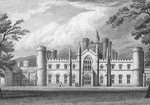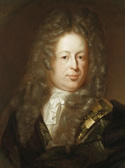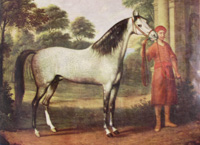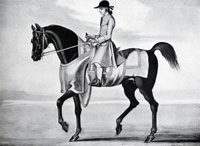 |
| Lowther Orientals |
 |
| Lowther Orientals |
 Lowther Hall  1st Viscount Lonsdale  Lonsdale Grey Arabian  Monkey, by the Lonsdale Bay Arabian |
Sir John Lowther (1655-1700), 1st
Viscount Lonsdale, succeeded his father as 2nd bt of Lowther and was
created Baron Lowther and Viscount Lonsdale of Kirby Lonsdale in
1696. From 1675 to 1696 he represented Westmorland in
parliament and in 1688 he armed and led a force of his tenants to
seize a ship at Workington harbour carrying arms and ammunition for
the garrison at Carlisle. Shortly thereafter he secured that part of
the north in preparation for the arrival of Prince William of Orange later that year. Sir John subsequently
became vice chamberlain of the newly invested King William III's
household and a privy councillor in February of 1688/89. He was
then named lord lieutenant for Westmorland and in 1690 he
was appointed first lord of the treasury. From March of 1699
until his death he served as lord privy seal. He married, in 1674, Katherine, daughter of Henry Frederick Thynne, 1st bt, of Kempsford, Gloucestershire. In 1685 he had begun the reconstruction of the old Lowther Hall, near Clifton, Westmorland (after which it was nearly destroyed by a fire in 1720), and lived for some time at Byram, near Ferrybridge in Yorkshire, the seat of Sir William Ramsden (1672-1736), 2nd bt, who was married to his daughter Elizabeth. Sir William is credited as the breeder of such horses as Hutton's Royal Colt (1685c Helmsley Turk), Basto (bl c 1702 Byerley Turk) and Godolphin's Whitefoot (b c 1719 Bay Bolton). Sir John Lowther was succeeded by his son Richard (1692-1713) who died unmarried at the age of twenty-one. His second son Henry Lowther (1694-1751) then took the reins as 4th bt of Lowther and 3rd Viscount Lonsdale. Henry Lowther also died unmarried, at which point the viscountcy became extinct but the baronetcy passed to his cousin Sir James Lowther (1736-1802), 5th bt of Lowther, 1st Viscount Lowther and 1st Earl Lonsdale, who was known as the "bad earl" but owned such good horses as Jason (gr c 1749 Old Standard), Ascham (br c 1759 Regulus) and Mirza (b c 1749 Godolphin Arabian). Whilst describing the Vintner Mare, the General Stud Book notes that the Lowther family had for many generations imported eastern blood and bred many good horses [GSB 1/5:17]. The Lowthers are associated with such early horses as Lonsdale's Counsellor (1685c Shaftesbury Turk) and the Lonsdale Royal Mare of Family 1, otherwise known as the Tregunwell Natural Barb Mare. |
| Lowther's White Legged Barb | |
| [Little Barb] ch c 1685c. Owned by the 1st Viscount Lonsdale,
he was possibly the same horse as Curwen's Chesnut Arabian as he
appears to have passed into the hands of Henry Curwen. He was mated
with Mr Curwen's Old Vintner mare, the taproot
mare of Family 9, to produce the Lowther Barb mare.
In turn the Lowther Barb mare became the third dam of the very
influential stallion and champion sire
Croft's Partner (ch c 1718
Jigg) and the fourth dam
of the champion sire Crab (gr c 1722
Alcock's Arabian). Crab sired Kingston's Othello* (bl c 1746)
who made his mark in America.
Croft's Partner sired Morton's Traveller* (b c 1748) who left an
indelible impression on bloodstock in colonial Virginia. Under the name of the Little Barb, he is recorded as the sire of an unnamed mare (1689c) who produced Flanderkin (c 1707 Curwen's Grey Turk) and his sister as well as a number of others who appear to have been in the stud of Cuthbert Routh. Her most successful offspring was perhaps Mr Routh's Hanniball (c 1713 Terror) the winner of the York Royal Plate in 1719. Hanniball was either the same horse as Singlepeeper or his twin. According to Cuthbert Routh's stud book Creeping Molly's dam was got by a little White leggd Barb of Mr Curwen's, out of a mare nobody can give any acct of [ER:27]. Creeping Molly was the dam of Warton's Commoner (gr c 1710c Crofts Commoner), who was also called Grey Commoner and Onslow's Commoner. In 1718 Lord Onslow`s Commoner won a match against the Duke of Wharton`s Winchindon [Baily`s Racing Register]. |
|
| Lowther's Bay Barb | |
| b c 1690c. According to the research of Highflyer he is the same horse as Curwen's Bay Barb and the Taffolet Barb. Owned by the 3rd Viscount Lonsdale, the Barb had one offspring, an unnamed mare, the second dam of Lonsdale's Spider (gr c 1729 Lonsdale Bay Arabian). Spider had several really good wins on the turf, notably the Wallasey Stakes at Newmarket where he defeated the Duke of Bridgewater's Poker, and he later covered for Henry Bateman in Westmorland for a fee of half a guinea. A sister to Spider, confusingly also called Spider (gr f 1730c) was the dam of an unnamed mare by the Lonsdale Black Arabian who was exported to Virginia and there became the grandam of John Tayloe III's stallion Nonpareil (c 1758c) and Thomas Nelson's stallion Lonsdale (b c 1759c). | |
| Lowther's Arabian | |
| c 1725c. Sir William Lowther (1694-1763), 2nd bt of Swillington, was married to, as his second wife, Catherine Ramsden, daughter of Sir William Ramsden (1672-1736), 2nd bt, and sister of Sir John Ramsden (1699-1769), 3rd bt. Sir William's great great grandfather was the brother of the grandfather of the 1st Viscount Lonsdale. The Arabian's only known offspring was the Duke of Perth's Chance (b g 1733) who racked up a string of victories in the north, including the Royal Plate at Edinburgh in 1739. He was rarely defeated and it took such good horses as Mr Martindale's Sedbury (ch c 1734 Croft's Partner) and Mr Routh's Whitefoot (ch c 1731 Hip) to do it. | |
| Lonsdale's Arabian | |
| c 1720c. Owned by the 3rd Viscount, it is possible that he was the same horse as one of the other Lonsdale Arabians. According to Ernest Hutton, who owned the portrait of the Lonsdale Grey Arabian, the Grey Arabian was styled the Lonsdale Arabian to distinguish him from the Lonsdale Bay Arabian and he sired Spider, Sultan and Nathan [The British Racehorse, Sept 1951, Early Pictures of Racehorses by Ernest Hutton, page 357]. Presumably this information was recorded on the portrait. Both Spider and Sultan are invariably recorded in other sources as sons of the Bay Arabian. The Lonsdale Arabian is said to have sired the Duke of Bridgewater's Nathan (b c 1725c) as well as two unnamed fillies. Nathan won two good matches worth 600gs at Newmarket in 1732. One of the fillies was the grandam of Mr Cross's Julius Caesar (ch c 1757 Young Cade) and the other was the fourth dam of, among others, HRH the Prince of Wales's Cumberland (br c 1779 Phlegon). Julius Caesar won King's Plates at Nottingham and Newmarket and a fifty at Ascot Heath. He got a number of offspring but none made any substantial mark on the stud book. Cumberland was sold at the Prince of Wales's sale in 1786 for 110gs to M de Constans. | |
| Lonsdale's Bay Arabian | |
| b c 1720c. Owned by Henry Lowther
(1694-1751), 3rd Viscount Lonsdale, he had around thirty offspring from 1725 to 1742. He covered
few mares other than those belonging to Lord Lonsdale, but was
said to have gotten excellent runners. The most notable of these
were colts. (1) Monkey (b c 1725) won an 800gs stakes at Newmarket
in 1730 and the Royal Plate at York in 1731. (2) Spider (gr c 1729)
won a number of big races, including the 600gs Wallasey Stakes at
Newmarket in which he beat the Duke of Bridgewater's Poker. (3)
Kouli Khan (b c 1739) won the Ladies Plate at both Lincoln and
Oxford. It is plausible that he was the damsire of the Khouli Khan
(b c 1758 Pearson's Little Partner) who was sent to Virginia in
1764. (4) Juba (b c 1731) won a 25gs each subscription at Newmarket
in 1736, defeating eight others. In the stud he got the good runner
Trifle (b c 1748) who won in both England and Ireland. (5) Cyprus (br
c 1732) won the Edinburgh Royal Plate in 1738 and got Carr's Tom
Jones (gr c 1745) who also won the Royal Plate at Edinburgh and was
thereafter sent Virginia where he got Tayloe's Smiling Tom (ch c
1757). The Lonsdale Bay Arabian is usually said to be the sire of of an unnamed mare (gr f 1736) from Bonny Lass (b f 1723 Bay Bolton) who is the ancestress of part of Family 1-a [GSB 1/5:41], however in order to account for her own colour and her grey descendants she must have been sired by the Lonsdale Grey Arabian instead. Two Derby winners, Rhadamanthus (b c 1787 Justice) and Daedalus (b c 1791 Justice), trace to her. However the Lonsdale Bay Arabian did get several other noteworthy daughters. (1) Sister to Monkey (1730c) was the dam of Earl Ferrers's Miss Tippett (b f 1742 Tate's Arabian) who won a fifty at Windsor in 1746 and finished 2nd for the Royal Plate for mares at Newmarket in 1747, won by the Duke of Ancaster's Dizzy. She was also the second dam of Mr Tate's Greybeard (Dormouse) who won fifties at Aylesbury, Swaffham, Epsom, Canterbury and Odiham. He also won the Ladies Purse at Oxford. (2) Julietta (b f 1735c) was the dam of the Hambleton Royal Plate winner Lisette (ch f 1752 Regulus) and the second dam of Willis's Rockingham (b c 1771 Lightfoot's Partner), an eminent American stallion. (3) Switch (br f 1739) was the second dam of the Hambleton Royal Plate winner Creeping Kate (ch f 1765 Babraham Blank) and the third dam of the York Royal Plate winner Comet (ch c 1788 Phoenomenon). |
|
|
|
|
| Monkey
(GB) b c 1725 (Lonsdale's Bay Arabian - Mare, by Curwen's Bay Barb - Mare, by Byerley's Turk - Arabian Mare). He was bred in England by Henry Lowther (1694-1751), 3rd Viscount Lonsdale, from purely Oriental ancestors. His pedigree was long unconfirmed in America and depended on a tradition that the imported Monkey was Lord Lonsdale's. Not until 1929 did the then Lord Lonsdale verify that his family papers in keeping at Lowther Castle recorded Monkey's sale to America, probably in 1737. Monkey raced only twice before entering the stud. In 1730 he won a 100gs each sweepstakes at Newmarket in April, defeating the Duke of Bolton's Fearnought (br c 1725 Bay Bolton), the Duke of Devonshire's [Old] Polly (ch f 1725 Childers), Sir Michael Newton's Grasshopper and the Duke of Somerset's Greylegs (gr c 1725 Wyndham), "all being in high form". In 1731 he won a King's Plate at York in August, defeating Sir Nathaniel Curzon's Brisk (gr c 1725 Bloody Shouldered Arabian), Mr Benson's Johnson (b c 1725 Johnson's Turk) and Mr Vavasour's Mercury (ch c 1725 Almanzor); three others were distanced in the first heat. Fairfax Harrison describes Monkey's impact on early American bloodstock: "It was thus the fate of Monkey to perform chiefly the humble office of breeding up a native stock. The interest in him today is two fold, that he performed that function well, imparting something magical to his filly foals which made of them the foundation stock for the successful quarter racers which it was the privilege of Janus ultimately to galvanize: and that he is the only horse imported into America before the Revolution of which a contemporary portrait has come to light." Probably imported by Colonel Nathaniel Harrison of Brandon, in Prince George County, Virginia, Monkey stood there for about a decade before moving on to North Carolina. He is said to have sired more than 300 foals in the two states. One of Monkey's unnamed daughters became the taproot mare of American Family A31, and another, the daughter of the Harrison of Brandon Mare contributed to American Family A10. He is a popular cross in old Virginia pedigrees. Monkey died in North Carolina in 1754 at the age of twenty-nine. |
|
| Lonsdale's Black Arabian | |
| bl c 1725c. Owned by Henry Lowther (1694-1751), 3rd Viscount Lonsdale, his half dozen known offspring date from 1731 to around 1740. In 1737 he was advertised to cover at Warwick, near Carlisle in Cumberland, for a fee of 10 shillings for Mr Joseph Paret. He was said to be in "good plight" at the time and as clear of blemish as the day he was foaled. His stock had the reputation for being large, strong, beautiful and successful. Among his runners were Mr Teasdale's Caesar (gr c 1733), winner of a plate at Newcastle-upon-Tyne in 1737, and the Earl of Berkshire's Little Harry (br c 1734), who ran in 1740. His daughter, the only offspring known to have bred on, an unnamed mare (1740c), foaled the Honourable William Nelson's Monkey Mare* (f 1751 Meredith's Monkey), who was the dam in America of John Tayloe's Nonpareil (c 1758c Morton's Traveller) and Thomas Nelson's Lonsdale (b c 1759c Jolly Roger), both stallions who appear in early Virginia pedigrees. | |
| Lonsdale's Grey Arabian | |
| gr c 1715c. Sire Line Lonsdale's Grey Arabian. He was probably the same horse as W Williams's Arabian and Wynn's Arabian. Owned by the 3rd Viscount, he was purchased from Thomas Wynn of Boston, Lincolnshire, around 1735. In the Lowther stud he appears to have gotten two offspring, of which only one had substantial further record. An unnamed mare (gr f 1736) was the ancestress of the 1778 York Royal Plate winner Diana (b f 1772 Shakespeare) and the 1782 Oaks winner Ceres (b f 1779 Sweetwilliam). The other, also an unnamed mare, was the second dam of Mr O'Kelly's Milesius (b c 1772 Eclipse) who ran at Bath in 1777. |